
Click the following link for a safe PDF copy: al-Zayla’ī Foundation for Media Production — “From the Sensible Leadership For Jihād In Somalia- A Warning To the Ummah From the Discoloration Of Abū al-Zubayr and Trying To Exploit the Developments In al-Shām”
___________
To inquire about a translation for this statement for a fee email: [email protected]
Month: May 2014
New article from Dr. Iyād Qunaybī: "Ten Points On 'Testimony To Preserve the Blood of the Mujāhidīn in al-Shām'"
بسم الله والحمد لله والصلاة والسلام على رسول الله.
1. كلمة الدكتور الظواهري حفظه الله (شهادة لحقن دماء المجاهدين بالشام) هي ما انتظره المتابعون لأمر الجهاد الشامي منذ عام لفهم ما يجري. ويبدو أن تأخر الدكتور في إصدارها كان سببه الحرص على حل المشكلة داخليا دون بيان أخطاء جماعة الدولة.
2. د. أيمن رجل شديد الأدب مع المسلمين عموما، وهذا من أخلاق المجاهدين. ومع أن فرع تنظيمه في العراق لم يخطره ولا الشيخ أسامة بإعلان دولة، ولا استشار في تولية البغدادي، ولا في إعلان “تمدد الدولة”، ومع أن ناطق جماعة الدولة وصف منهج الدكتور بالانحراف، إلا أن د. أيمن عاد بعد حدته إلى لين الخطاب مع البغدادي (نسأل الله أن يهديه) وخاطبه بالشيخ المكرم الحسيني، رجاء أن يؤوب إلى ما فيه فلاح المسلمين.
3. ولا ينبغي مؤاخذة د. أيمن بأنه بلين خطابه هذا قد هوَّن مما فعلته جماعة الدولة. بل بين في كلمته أنها شقت الصف وتسببت في نفع النظام النصيري وأسالت دماء المسلمين. ورفض فرضها لــ “دولة” على الناس وعلى الفصائل الأخرى وبين أن من أسباب عدم مشروعية “تمددها” أنه لم يكن بمشورة مع هذه الجماعات. فرفقا بالشيخ أيها الناس، فهو لا يستهين بحقوق المسلمين، بل يترفق بالحديث من باب طرق جميع الأساليب لحقن الدماء بعدما أغلظ لهم الخطاب من قبل.
4. لكن هناك أمراً توقع البعض أن يكون أوضح في الكلمة. فمطالبة أبي بكر البغدادي بالرجوع إلى العراق –هداه الله للاستجابة لذلك- لا بد أن تكون مقرونة بالتأكيد على تغيير جذري في طريقة تعامل الجماعة. ولعل الدكتور أشار إلى ذلك بتأكيداته على أن المطلوب هو عودتها لمواجهة أعداء أهل السنة في العراق. وإلا فلا يمكن تناسي شكاوى الفصائل المجاهدة في العراق كأنصار الإسلام من سلوك جماعة “الدولة” ورسائلهم التي نشروها مبينين فيها بالأسماء والوقائع حصول اعتداءات وقتل من جماعة الدولة في حق أمرائها وطلاب علمها، ومطالبين الدكتور أيمن بالتدخل لوقفها، وهي ذات شكاوى جيش المجاهدين في كتابه: (الدولة الإسلامية بين الحقيقة والوهم)، والذي نشره ردا على وصف العدناني لهم بالصحوات.
وإنا لنخشى أن يكون ما يعانيه المشروع الجهادي والقيادة في خراسان الآن من جماعة “الدولة” وعصيانها لها وتجرؤها عليها، نخشى أن يكون ذلك دفعا لثمن تأخرها في إنصاف هذه الجماعات، واستمرارها في الثناء على جماعة “الدولة” علنا على ما تلبست به من مظالم من قبل في حق الناس. ولعل القيادة كانت تناصح الجماعة في السر وتضغط عليها لترد المظالم، والله أعلم.
لكن لعل التوازن كان يقتضي ألا يمنع الاعتراف بالجانب المشرق من جماعة “الدولة” وتحريرها للسجناء ومواجهتها للمحتل وأذنابه، ألا يمنع ذلك من استنكار المظالم والتبرؤ منها بحزم، والإلزام برد الحقوق إلى أهلها.
لعل سُنة (اللهم إني أبرأ إليك مما صنع خالد) كانت تقتضي ألا يمنع خوف إعطاء ذريعة للإعلام وأعداء الإسلام من الانتقاد العلني للأخطاء، تنزيها للشريعة والجهاد، وخوفا أن ينفر الناس عن دينهم.
5. للسبب نفسه فلعل الناس كانوا يتوقعون من الدكتور حفظه الله أن يُلزم البغدادي بالخضوع للتحكيم الشرعي فيما يُنسب إليه من مظالم مهما صدر من حكم له أو عليه فيها، قبل مطالبته بالعودة جنديا في صفوف أميره، وقبل التأكيد له بأن اتخاذ قرار الانحياز للعراق سيجعل (إخوانِك المجاهدين وكل أنصارِ الجهادِ أعوانًا لك وسندًا ومددًا). لئلا يُفهم من الخطاب إسقاط هذه الحقوق والمظالم أو عدم العناية بها، وهو ما لم يعنِه حفظه الله يقينا.
6. خاطب الدكتور البغداديَّ بالشيخ المكرم الحسيني، وهي عبارات مُشعرة بالعدالة المؤهلة لإمارة جماعةٍ مجاهدة. لن نناقش هنا بقاء هذه العدالة أو سقوطها بما وقع من الجماعة في ساحة الشام. بل السؤال الذي يطرح نفسه بإلحاح هنا: هل يعلم الدكتور أن قيادة جماعة “الدولة” كانت ابتداء مستحقة لهذا التكريم؟
نتفهم تماما رغبة الدكتور حفظه الله في حقن الدماء ونتمناه كما يتمناه، لكننا هنا أمام أناس يتخذون ثناءه هذا سببا لإضفاء الشرعية على “دولة” البغدادي على أنها دولة استوفى أميرها شروط اعتباره (أميراً للمؤمنين)!
وضح الدكتور أن القيادة في خراسان طلبت نبذة عن البغدادي ونائبه وأنهما غير معروفين لدى القيادة. فمن حق الأمة أن تعلم: بماذا جاء الرد؟ هل تبين للقيادة عدالة البغدادي ومن حوله وتَأَهُّلهم علميا لقيادة جماعة تجاهد جهادا رشيدا، فضلا عن التأهل لقيادة دولة؟ فضلا عن ادعاء إمارة المؤمنين؟!
هذا سؤال انتظر كثيرون الإجابة عنه من د. أيمن، ومن زمن طويل: من يعرف البغدادي وقياداته؟ ومن زكاهم؟
7. أثبت خطاب الدكتور أن البغدادي كان جنديا عنده. فإن كنا نتحدث عن دولة أميرها هو نفسه جندي ومأمور في نفس الوقت، ودولته جزء من تنظيمٍ وتابعة له، فمعنى هذا أن هذه الدولة ليست دولة يجب لأميرها الطاعة ولا البيعة، وإنما هو أمير خاص لجزء من جماعة، يقالُ ويعيَّنُ من غير أن يكون له أن يتأمر على غيرِ مَن عُين أميرا عليهم! فالتمدد بعد ذلك قهر وتسلط غير مشروع.
فادعاء البغدادي للإمامة العامة ثم ادعاء حق التمدد بناء عليه كان إذن تشبعا منه بما لم يُعط. و ((المتشبع بما لم يعط كلابس ثوبي زور)). فكيف يدعي لنفسه ذلك وهو جندي مأمور؟! ولماذا إذن حاولت جماعة “الدولة” خلال الفترة الماضية التنصل من الاعتراف بتبعيتها للظواهري إلى أن أثبتها الدكتور بنفسه؟ ألا تعلم الجماعة أن هذه التبعية تحرمها حق الإمامة العامة؟ ثم ألا يكون هذا السلوك من مراوغة عن الحقيقة وادعاء ما ليس بحق لها واضعا لعدالة أميرها محل تساؤل؟
8. لأسباب نشرحها لاحقا بإذن الله، لا نعتقد أن ما قام في العراق أصلا كان يصح أن يُسمى دولة. ولو صح، فإن هذه الدولة قد زال “تمكينها” فكان لها في تحرير نفسها من الاحتلال، وفي تحرير 4500 أسيرة من “رعاياها” في سجون النظام العميل شغلٌ عن “التمدد” لمناطق أخرى لتحررها من المجاهدين!!
وليس كلامي هذا استهانة بالجانب المشرق من جهد الجماعة في العراق. إنما نقول: لا يصح اعتبارها دولة لأسباب كثيرة جدا، أحدها غياب المشورة.
ذكر الدكتور حفظه الله أنه–بعد إعلان الدولة دون مشورة القيادة- جاءتهم تطمينات بحصول شورى موسعة بين الجماعات المجاهدة في العراق قبل إعلانها. والسؤالان الملحان هنا:
أ) إن كانت الجماعة تتعامل مع قيادتها العامة في كل أمر مفصلي من إعلان دولة وتعيين أمير جديد ثم إعلان “تمدد” بهذه الطريقة، دون استئذان ولا مشورة، وإنما –في أحسن الأحوال- إخطارٌ بعد الوضع تحت الأمر الواقع، فكيف يُتصور أنها أخذت
Minbar al-Tawḥīd wa-l-Jihād presents a new article from Abū Muḥammad al-Maqdisī: "Stand For the Attacks Of Evil To Defend Our Senior Media"

Click the following link for a safe PDF copy: Abū Muḥammad al-Maqdisī — “Stand For the Attacks Of Evil To Defend Our Senior Media”
__________
To inquire about a translation for this article for a fee email: [email protected]
Hizballah Cavalcade: Liwa ‘Abis: A New Active Militant Group in Bahrain
NOTE: For prior parts in the Hizballah Cavalcade series you can view an archive of it all here.
–
Liwa ‘Abis: A New Active Militant Group in Bahrain
By Phillip Smyth
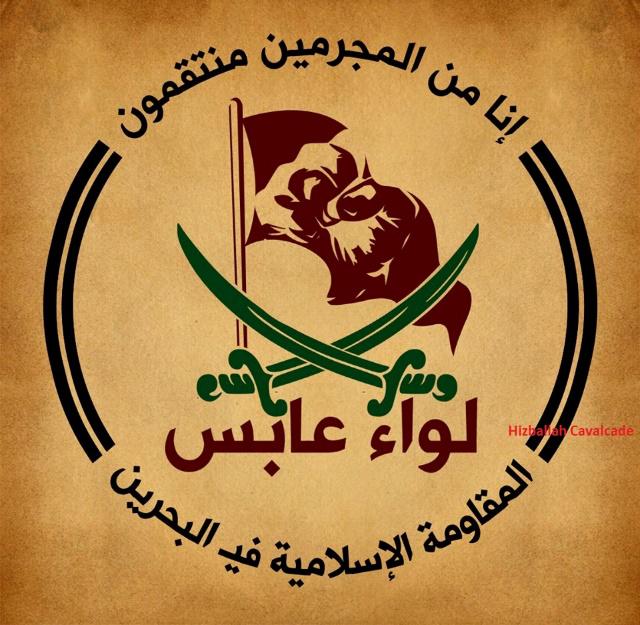
Figure 1: Liwa ‘Abis’s logo.
Liwa ‘Abis (the ‘Abis Brigade) declared their existence in an announcement dated April 7, 2014 and released it on Facebook and Twitter on April 8. The group’s first announcement declared they were joining those who “preceded” them in “jihad and resistance” against the “oppressors,” meaning the government of Bahrain. As with other radical anti-government organizations, which utilize force, Liwa ‘Abis call their enemies, meaning Bahrain’s internal security forces, “mercenaries.” This terminology is common among Bahraini militant organizations. According to Liwa Abis’s, their attack(s) are representative of the “legitimate jihad” they were waging against the government of Bahrain. Combined with the group’s self-description as “Al-Muqawama al-Islamiyya fi Bahrain” (“The Islamic Resistance in Bahrain”), the group appears to share many themes with other Bahraini militant organizations.

Figure 2: Liwa ‘Abis’s first announcement.
Liwa ‘Abis’s Targets & Their War on the “Occupier’s Economy”
A developing trend among Bahraini militant groups has been to target infrastructure and economic targets. Saraya al-Mukhtar has attacked Automatic Teller Machines (ATMs). Attacks against ATMs occurred in January, February, and March, 2014. These activities led the U.S. Department of State to issue specific travel warning instructions to U.S. citizens in Bahrain, telling them to, “Use caution when approaching ATMs, particularly at night and early morning, by scanning the area for items that are out of place or suspicious to the area in general.”[1]
Liwa ‘Abis appears to have also adopted a strategy of attacking economic targets. These targets have included structures—which the group has argued—assist with the “Saudi occupation” and the Bahraini government.
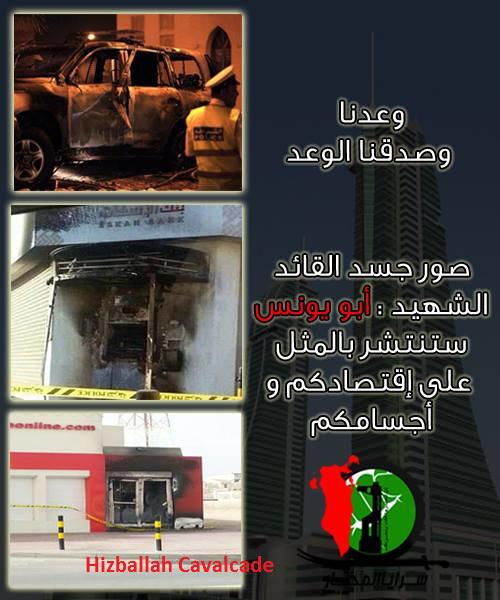
Figure 3: A Saraya al-Mukhtar edited image showcasing their targeting of economic interests. Bombed-out banks and ATMs are shown on the left. The Bahrain Financial Center—likely a broader warning that other pillars of the Bahraini economy will be targeted—is used as a background on the right.
In late-April, a Liwa ‘Abis operation claimed to attack a factory. Their statement said this plant was flying the flag of the “Saudi occupation” and that the owner of the structure supported the government. The attack on the factory was also claimed to be the first in a campaign the group launched, which coincides with protests of the same name: “Symptoms of the Intifada.” Liwa ‘Abis referred to their operation as “Symptoms of the Intifada 1.”
Interestingly, the statement also claims that the “Rijal Allah” or “Men of God” of “Saraya ‘Abis” (the ‘Abis Brigades) conducted the attack. The term “Rijal Allah” has been adopted by Iranian-backed Shia Islamist militants operating in Syria.
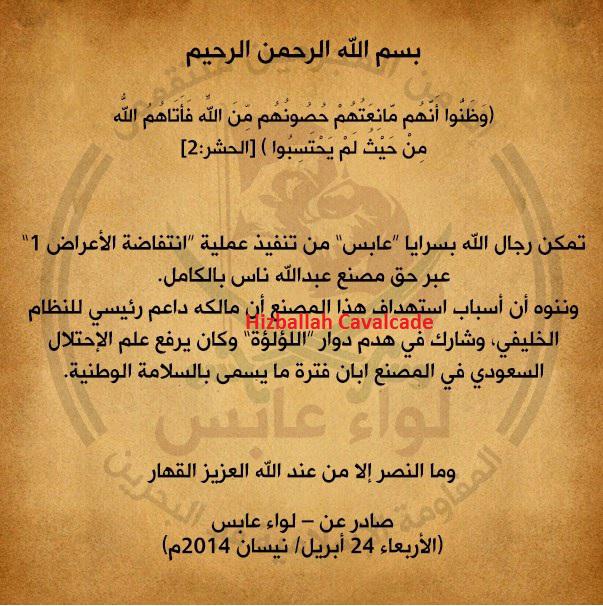
Liwa ‘Abis has also claimed attacks against the Bahraini police. On April 11, 2014 the organization claimed on Facebook that they had attacked a police station in Sitra. The group stated the attack was to gain vengeance for Hasan Mushaima, an exiled anti-government Bahraini Shia leader of the Haq Movement. Attacks by firebomb wielding youths against police stations in Sitra have occurred since 2012.[2] Additionally, Sitra has also been the scene of improvised explosive device-based attacks against Bahraini internal security forces.[3]
Symbolism
Liwa ‘Abis’s name likely refers to ‘Abis bin Abi Shabib, one of Imam Husayn’s loyal, militarily prominent, and powerful companions during the Battle of Karbala.[4]
The group’s logo features two crossed green swords and a red banner with a fist emblazoned on it. The stylized fist, which bears a striking similarity to the fist featured on the logo of Saraya al-Mukhtar. These images are encapsulated in a circular shaped combination of lines and text. As with other Bahraini militant groups, it’s possible the circle may represent the pearl, a symbol of Bahrain.
On the top of the group’s symbol sits a section from Quran 32:22. The entire passage from the Quran reads “And who is more unjust than one who is reminded of the verses of his Lord; then he turns away from them? Indeed we, from the criminals, will take retribution.” This is a clear reference to a number of themes expressed by Bahraini militants, particularly those affiliated with Saraya al-Mukhar. The first is “revenge” for perceived crimes against protesters executed by forces belonging to the Bahraini government. Another theme surrounds how militants consider the ruling Khalifa royals. Using a passage like Quran 33:22 may suggest these groups consider the Khalifas and those who support them to be infidels. Additionally, charges by government media organs which consider militants to be terrorists and vandals are also addressed with the Quranic passage, by flipping the tables and accusing the government of being the true criminals.
___________
[1] See: https://photos.state.gov/libraries/saudi-arabia/323264/riyadh/security_message_for_u_s_citizens-bahrain_situaiton_3-6-2014.pdf
[2] See: https://youtu.be/3mUPS6Eq4Hk. This clip was released in April, 2013.
[3] See: https://www.bbc.co.uk/arabic/middleeast/2013/07/130707_bahrain_bomb_sitra.shtml.
[4] See: https://www.islamquery.com/documents/companions%20of%20Imam%20Husain.pdf.
Hizballah Cavalcade: Singing Hizballah’s Tune in Manama: Why Are Bahrain’s Militants Using the Music of Iran’s Proxies?
NOTE: For prior parts in the Hizballah Cavalcade series you can view an archive of it all here.
–
Singing Hizballah’s Tune in Manama: Why Are Bahrain’s Militants Using the Music of Iran’s Proxies?
By Phillip Smyth
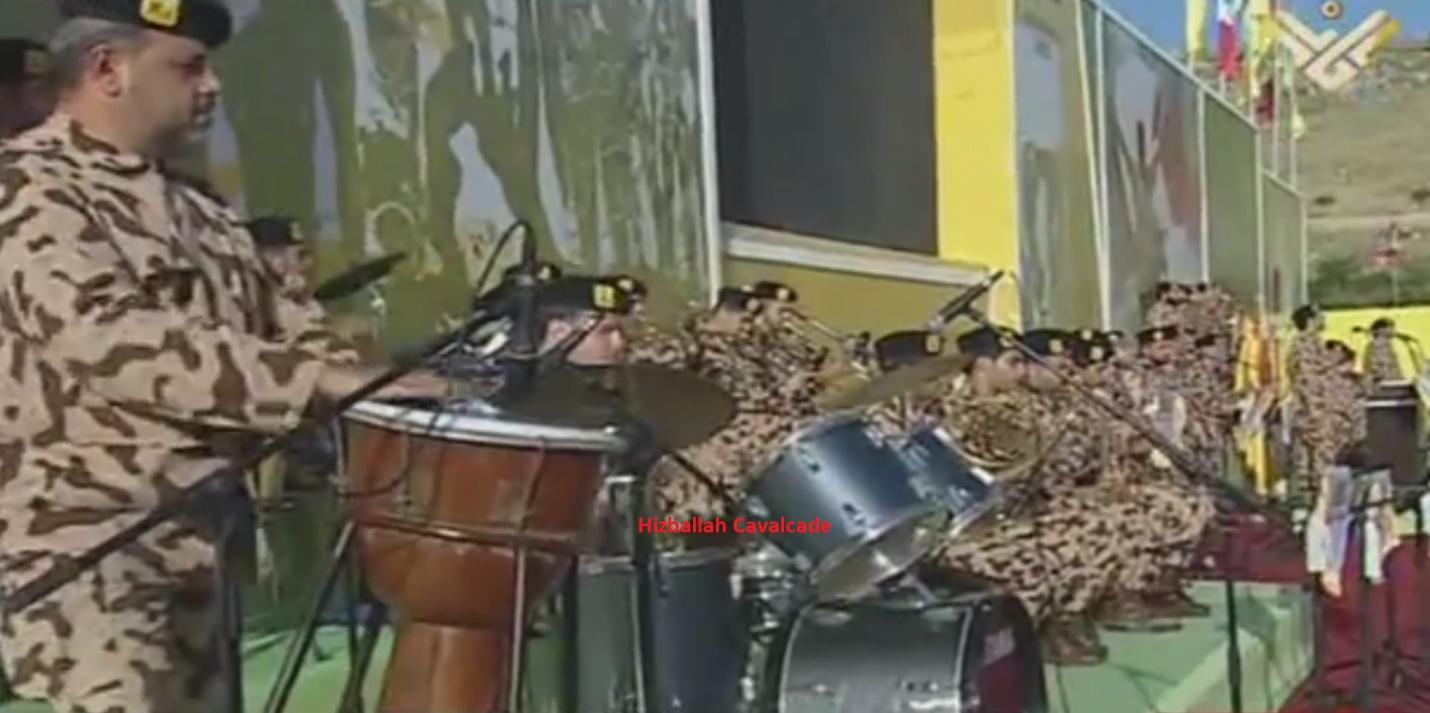
Figure 1: A screenshot of a Hizballah musical band performing at the 2013 “Resistance and Liberation Festival”
Bahraini officials have repeatedly accused anti-government militants and protesters in the country of being supplied, trained, and supported by Iran and its numerous regional proxies. Still, the government of Bahrain has done little to bolster their claims of deep and intrinsic links between Bahraini militants and Tehran. Along with official Iranian denials, the issue of Iran-Bahraini militant links is still quite hazy. Nonetheless, this does not mean that within the material released by Bahraini militant organizations that there are not hints of some level of Iranian influence. One of the more intriguing pieces pointing to influence from Iranian-backed organizations comes from the utilization of specific types of music in the many propaganda videos released by Bahraini militants, their sympathizers, and amplifiers.
Numerous instances of Bahraini militants producing propaganda videos with different varieties of music created and utilized by Iranian-backed proxies could indicate a connection with Iran’s proxies. Nevertheless, this type of overlap should not be viewed as a “smoking gun” affirming Iranian involvement. However, it does assist in piecing together direct and indirect influences.
The pieces of music in question were originally developed and used by Iranian proxy organizations, particularly Lebanese Hizballah, Asa’ib Ahl al-Haq (AAH), and Kata’ib Hizballah. In fact, some of the songs that have been promoted fit a long standing media strategy employed by the aforementioned groups and Iran when manufacturing narratives and perceptions for themselves and other armed groups.
The use of music as a transferable propaganda medium follows a very formulaic strategy used by Iran and its “Islamic Resistance” proxy organizations for many years. Often, songs produced for one group are repackaged for newer organizations in other geographic locations. The songs are then altered in a way to make them appeal to the populations and target audience where the new group is located.
Possible Reasons for Using Specific Songs
Why would Bahraini militant groups utilize Hizballah and its Iraqi clones’ music and with such frequency? Some possible answers include:
- Direct Iranian influence or assistance provided to the developing militant groups.
- Video editing/production was offered to Bahraini militants by Iran and/or its proxies as a means to influence and shape militant organizations and to encourage the adoption of a more bellicose strategy to the broader (and more peaceful) protester audience.
- Bahraini militants sympathize with Iranian-proxy groups, their exploits, and with the general concept of “Al-Muqawama al-Islamiyya” (“The Islamic Resistance”). The hope to be as successful, feared, and/or respected as those organizations has led them to adopt the same varieties of music.
- Thumbing their nose at the government: With the government of Bahrain accusing protesters and militants of being Iranian proxies, militant groups may use the material as a way to subtly frighten or encourage speculation among Bahraini government and other observers.
- Narrative Goals: One song by Lebanese Hizballah’s Ali al-Attar called “Wa’ad al-Asra” or “The Prisoner’s Promise” was written to celebrate the release of prisoners Hizballah sought to free during the 2006 Hizballah-Israel War. While the song makes clear references to Lebanese Hizballah and themes related to the 2006 war, the same song was employed by some Bahraini protesters (as background music for their uploaded clips) when they protested the government’s detention of key protest-leaders.
Auto-Tuning the Revolution: Examples of the Musical Overlap
In March 2014, a music video which was claimed to have been produced by “Saraya al-Bahrainiyya al-Muqawama” or the Bahraini Resistance Brigades, (which is likely another name used by The February 14 Youth Coalition’s Saraya al-Muqawama al-Sha’biya [Popular Resistance Brigades]) was posted by the popular Revolution Bahrain’s YouTube Channel. The video featured a montage of edited clips, which purported to show Bahraini militants engaged in training. The music video also included a number of videos of bombings orchestrated by militant Bahraini organizations.
Yet, the music used was strikingly familiar in the circles of Iranian-backed Shi’a Islamist groups. In fact, Iranian-backed Iraqi group, Asa’ib Ahl al-Haq had released the exact tune back in 2011 to commemorate attacks the group orchestrated against U.S. targets to demonstrate solidarity with Bahrain’s protesters. Later in 2011, when fellow Iranian proxy Kata’ib Hizballah released footage of attacks it had also launched in solidarity with Bahraini protesters, it too used the same song.
However, the song was neither originally Bahraini nor Iraqi, instead its origins were rooted father to the west, in Lebanon. The original song, “Risalat al-Thuwar” (“Message of the Rebels”), was performed by one of Lebanese Hizballah’s official bands, Firqat al-Fajr (The Dawn Band), following the 2006 Hizballah-Israel War. It first appeared on the band’s 2007 “Lahan al-Turab” or “Melody of the Soil” album. Still, the rendition dealing with Bahrain was not the only version of the song. Asa’ib Ahl al-Haq had their own Iraq/Grand Ayatollah Muhammad Muhammad Sadiq Sadr (as opposed to Sayyid Hassan Nasrallah) themed “Risalat Thuwar” produced in 2011.
“Risalat al-Thuwar” is not the only Hizballah song which has been adopted and rebranded by Bahraini militants and their amplifiers. Another song used by Bahraini militants also comes from Firqat al-Fajr. The song, “Ya Wa’ad Allah” (“O Promise of God”) can be found on the group’s 2008 album, “Sharit Wa’ad Allah” (“Take the Promise of God”). The song has been released in different formats, with more recent music video varieties showcasing the assassinated Hizballah terror-mastermind Imad Mughniyeh. The album also included an instrumental version of the song. Both versions have been prominent features on productions done by Hizballah’s Al-Manar TV network.
In Bahrain, “Ya Wa’ad Allah” was used as background for clips released to the popular (particularly with militant groups) Revolution Bahrain’s YouTube account. One of these videos included the firebombing of an armored car used by Bahraini government forces.
It is not just the polished music video-quality material finding its way into Bahraini militant propaganda productions. Bahraini militant group Saraya al-Mukhtar released a video of their April 2014 targeting of Bahraini police with an improvised explosive device. Another bomb attack in Bani Jamra also utilized the same background music.
The musical selection in the background matched with instrumentals used by Iraq’s Asa’ib Ahl al-Haq. This music was first featured on the AAH-affiliated Al-Ahad TV in the late summer/fall of 2013 to commemorate Asa’ib Ahl al-Haq members killed fighting in Syria. Further pointing to some level of Iranian or Iranian proxy influence, is highly unlikely that this particular musical element could find its way into so many pieces of released footage. This may indicate some Bahraini militant footage being sent abroad (possibly to Iraq) where the footage is re-edited and put back together for a later introduction.
Another similar instrumental used by Bahraini militants with Saraya al-Mukhtar and Saraya al-Ashtar was also the same exact tune utilized in a number of Kata’ib Hizballah video releases (see: 00.17-00.40 on “Kata’ib Hizballah Anti-America Video”).
The use of the last two instrumentals create further questions. Why would these groups, which have resorted to using a variety of improvised weapons, and exist under increasing heavy security crackdowns, spend the time to find, edit, and utilize background instrumentals which already have obscure points of origin. Why pick these two exact instrumentals, which have only been found in the repertoire of Asa’ib Ahl al-Haq and Kata’ib Hizballah? Other Bahraini protest organizations have utilized a variety of different musical accompaniments. Thus, the use of these particular musical pieces seem out of place when compared to the rest of what has been released.
Whatever the reasons, closely assessing the propaganda published by these organizations may provide insight into rather opaque organizations. While assessing the musical selections may appear to be a tangential escapade, AAH, Kata’ib Hizballah, and Lebanese Hizballah have all demonstrated their strategy of using this material as another method to push the narrative of the “Islamic Resistance.”
al-Batār Media Foundation presents a new article from Abū Ḥāmid al-Barqāwī: "The Islamic State and the Leadership Position"

Click the following link for a safe PDF copy: Abū Ḥāmid al-Barqāwī — “The Islamic State and the Leadership Position”
__________
To inquire about a translation for this article for a fee email: [email protected]
New statement from Katībat al-Zarqāwī in Bilād al-Ḥaramayn: "Founding Statement"
البيان رقم (1)ـ
بسم الله الرحمن الرحيم
الحمد لله رب العالمين القائل في كتابة الكريم (يأيها النبي جاهد الكفار والمنافقين وأغلظ عليهم) والقائل في محكم التنزيل (واقتلوهم حيث ثقفتموهم)ـ
والصلاة والسلام على أشرف الأنبياء والمرسلين قائد المجاهدين الناطق بلسان الوحي المبين (أخرجوا المشركين من جزيرة العرب)ـ
وانطلاقا من الأوامر الإلهية وحيا كان أم سنة نعلن نحن في الكتيبة الزرقاوية في بلاد الحرمين الأمر لجنودنا ببدء العمليات الجهادية ضد الرافضة المجوس على أرض الحرمين وذلك لتطهيرها من شركهم و خزعبلاتهم وكفرهم بالله وطعنهم في أمنا عائشة رضي الله عنها وسبهم لأبي بكر وعمر رضي الله عنهما في (حسينياتهم) ومجالسهم الشركية وطقوسهم الكفرية في أي مكان تقام فيه وخاصة في مكة المكرمة والمدينة المنورة لذلك ننبه لما هو آت:
1- سنستهدف كل المظاهر الشركية التي يقوم بها الروافض في بلاد الحرمين
2- سنستهدف من يداقع عنهم ويحميهم
3- سنستهدف الفنادق التي تسكنهم
4- سنستهدف السيارات التي تقلهم
وكل ماسبق تعتبر أهداف مشروعة لمفخخاتنا وللأنغماسيين الأستشهاديين الذين سيطهروا بلاد الحرمين من رجس الروافض لذلك ننبه كل من يرى هذه المظاهر الشركية بالابتعاد عنها وعدم الاقتراب منها، كما ندعوا كل مسلم موحد للأنظمام لنا والبدء بالمشاركة في العمليات كلا في منطقته .
فسيروا على بركة الله ياجنود الكتيبة الزرقاوية وتذكروا سيرة البطل الشهيد ابو مصعب الزرقاوي وكيف مرغ أنوف الرافضة توكلوا على الله واستعينوا به هو مولاكم وناصركم ونعم المولى ونعم النصير
هذا والله ولي التوفيق
عزام
(أمير الكتيبة الزرقاوية)
__________
To inquire about a translation for this statement for a fee email: [email protected]
New video message from Himam News Agency: “Report 79: Jabhat al-Nuṣrah Distributes Flour To the Muslims In Eastern al-Ghūṭah – Damascus"
NOTE: For previous parts in this video series see: #78, #77, #76, #75, #74, #73, #72, #71, #70, #69, #68, #67, #66, #65, #64, #63, #62, #61, #60, #59, #58, #57, #56, #55, #54, #53, #52, #51, #50, #49, #48, #47, #46, #45, #44, #43, #42, #41, #40, #39, #38, #37, #36, #35, #34, #33, #32, #31, #30, #29, #28, #27, #26, #25, #24, #23, #22, #21, #20, #19, #18, #17, #16, #15, #14, #13, #12, #11, #10, #9, #8, #7, #6, #5, #4, #3, #2, and #1.
—
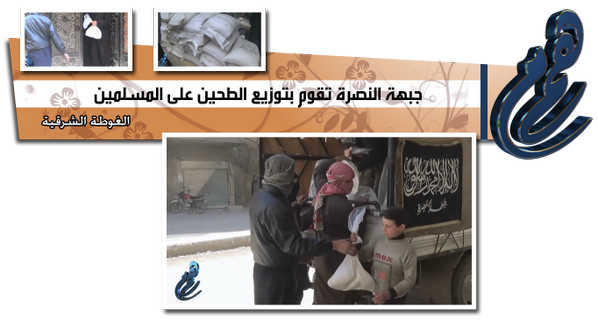
_________
To inquire about a translation for this video message for a fee email: [email protected]
New video message from al-Baṣīrah Foundation for Media Production: "Picture of Sharī'ah Courses Held By Jabhat al-Nuṣrah For the General Muslims and the Soldiers Of the Combat Battalions – Eastern al-Ghūṭah – Damascus"
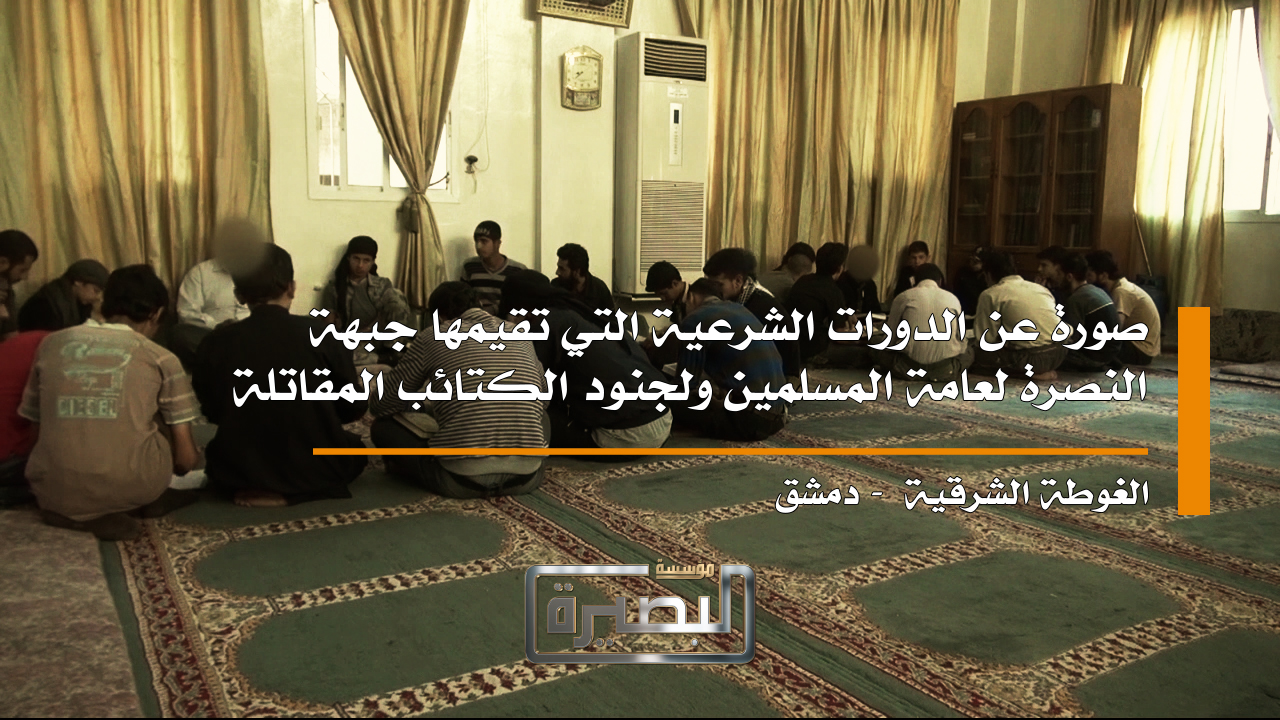
__________
To inquire about a translation for this video message for a fee email: [email protected]
‘Ā’ishah Media Center presents a new article from Muḥammad bin ‘Umar: "Jihād Of the Elite Or Jihād Of the Ummah?"
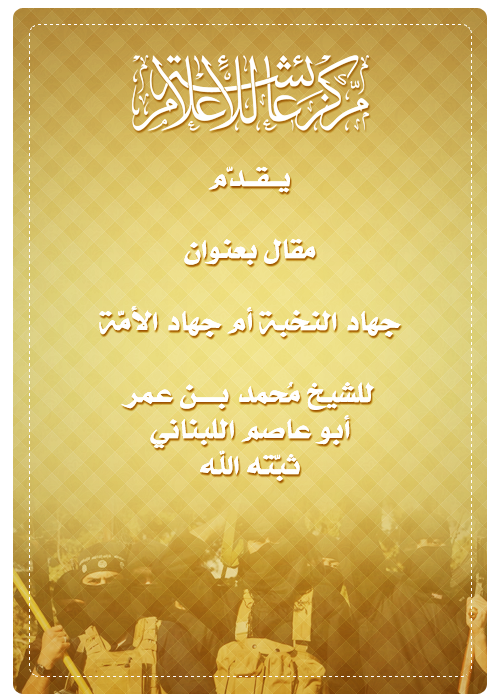
Click the following link for a safe PDF copy: Muḥammad bin ‘Umar — “Jihād Of the Elite Or Jihād Of the Ummah?”
_________
To inquire about a translation for this article for a fee email: [email protected]
